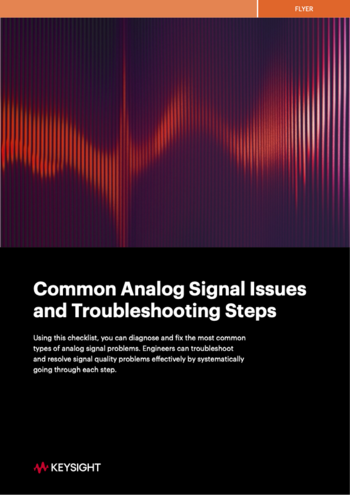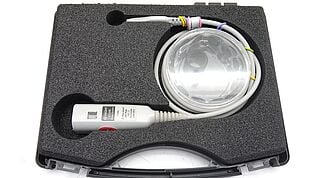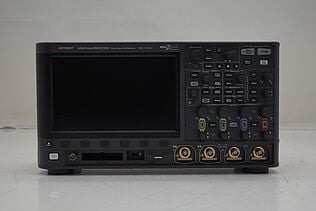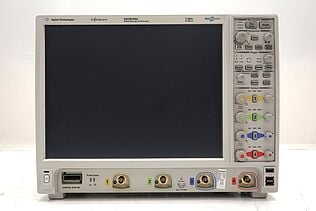Buy Oscilloscopes at a Great Discount
What is an Analog Signal? Meaning &Definition
A signal is an electrical representation of data. Signals can represent messages, images, sounds, measurements, and anything else defined as a set of values.
This article will discuss analog signals, how they are processed, and the tools used to process analog signals. An analog signal is different from a digital signal in that analog signals are continuous, with infinitely small gradations between the data points. Digital signals are discrete, with distinct values at set intervals.
What is an analog electrical signal?
An analog signal is a voltage, current, or physical quantity that continuously and infinitely varies in accordance with some time-varying parameter. For example, radio waves, television waves, or sound waves are all examples of analog signals.
There are two types of analog signals:
- Continuous-time signals: Any continuous function of time is considered a continuous-time signal. The most common example is the sinusoid.
- Discrete-time signals: Any sequence of real numbers separated by equal time increments (or samples) is considered a discrete-time signal. A common example is the digital audio signal, representing a series of instantaneous amplitudes at equal time increments

 Common Analog Signal Issues and Troubleshooting Steps
Common Analog Signal Issues and Troubleshooting Steps
Using this checklist, you can diagnose and fix the most common types of analog signal problems. Engineers can troubleshoot and resolve signal quality problems effectively by systematically going through each step.
Download for Free With a Keysight Used Equipment Store Account
Analog signal processing
Analog signal processing uses electronic devices to perform various operations on continuous analog signals such as amplification, filtering and limiting. It involves continuous-time processing in which quantities vary continuously with time.
Tools used in analog signal processing include oscilloscopes, power supplies, function generators, signal generators, RF analog signal generators, and other electronic test equipment.
- Oscilloscope: An oscilloscope is a type of electronic test equipment that allows engineers to see the behavior of an electric circuit in real-time. The input signal from a circuit being tested is sent from an input channel to the "horizontal" input on the scope, and then displayed as a waveform on the screen.
- Power supplies: Electronic devices that convert low-voltage, high current voltage into a more usable form.
- Function Generators: A function generator is a piece of electronic test equipment that produces waveforms. These are used to test the proper operation of other pieces of electronic test gear or to create audio signals for listening or measurement. Most function generators produce a variety of waveforms, switched into the circuit by a button on the front panel. These waveform types include sine, sawtooth, triangle, square, pulse, and ramp.
- Analog audio signal generator: In electronics, an audio signal generator is a piece of electronic test equipment that generates electrical signals in the audio frequency range. These signals are usually created using a voltage-controlled oscillator or a pulse train and then route to an amplifier before being sent to the loudspeakers, whose output makes up the desired sound.
- Function Generators: A function generator is a piece of electronic test equipment that produces waveforms. These are used to test the proper operation of other pieces of electronic test gear or to create audio signals for listening or measurement. Most function generators produce a variety of waveforms, switched into the circuit by a button on the front panel. These waveform types include sine, sawtooth, triangle, square, pulse, and ramp.
- RF analog signal generator: An RF analog signal generator is a piece of test equipment used to generate and apply signals such as sine waves, square waves (pulse), sawtooth waveforms, and triangle waveforms. It can also be used to sweep the frequency over a given range
Measuring analog signals
The amplitude of an analog signal source is measured in volts, and the frequency of an analog signal is measured in Hertz. The unit for a sine wave's peak-to-peak voltage amplitude is called the volt. The relationship between volts and current can also be expressed in terms of amperes through Ohm's law: volts = current × resistance.
Voltage is one of the most common and convenient forms of energy because it requires less space than other types of energy, such as current.
Information obtained from an analog signal
Analog signals contain three types of information:
- Magnitude (or amplitude)
- Frequency
- Phase
Magnitude: The voltage of an AC sine wave is proportional to both its peak-to-peak value as well as its average value. For example, if we had two sine waves with different amplitudes but equal frequencies, they would be indistinguishable on an oscilloscope unless we normalized their amplitudes first. If we divide each voltage measurement by the amplitude of the signal, then we can use voltage as an independent variable.
Frequency: The angular frequency of a waveform is the number of radians per second that it oscillates through, and it can be measured in hertz (cycles per second). For example, if we have two sine waves with different frequencies but equal amplitudes, they would be indistinguishable on an oscilloscope unless we normalized their amplitudes first. If you multiply each frequency by its corresponding normalized amplitude measurement, you can use frequency as an independent variable.
Phase: Phase is how much "behind" or "ahead" of time a waveform is compared to another waveform with the same frequency and magnitude. It can be thought of as how far along in its cycle the waveform is.
Using an oscilloscope to measure analog signals
An analog oscilloscope is a measuring instrument used to display time-varying analog signals as waveforms on the screen. The waveform displayed on the screen can be either an AC (alternating current) signal or a pulsed DC (direct current) signal.
- An AC signal is a signal whose voltage or current is subject to frequent and repeated reversals in polarity.
- A DC signal is a signal whose voltage or current is constant in polarity.
A digital oscilloscope is an instrument that digitizes and displays a waveform on the screen. It uses the principle of sampling to measure analog signals. A sample is taken of the input signal at discrete instances in time, called samples, and these samples are then plotted as voltage levels across the x-axis (time axis).
Analog signals can be displayed with either vertical or horizontal deflection, while digital signals only display well using horizontal deflection.
With respect to bandwidths and speeds, analog scopes tend to have wider bandwidths but slower sweep speeds than digital scopes, which tend to have narrower bandwidths but faster sweep speeds. In addition, because of the nature of analog signals, the oscilloscope must rebuild the waveform for each new screen update, causing a delay between measurements and affecting the scope's bandwidth and speed.
Measuring voltage signal with an oscilloscope
A voltage signal is measured in terms of its amplitude, also known as the strength or intensity. Voltage signals are usually measured with respect to ground because they are easy to measure when there is a reference point. There are cases where both positive and negative voltages are used in an experiment, so the oscilloscope needs to have two vertical channels for each input being monitored to display both polarities of the waveform simultaneously.
Controls on an analog oscilloscope
The controls on an analog oscilloscope are the different options that allow you to control how your input signal is displayed on its screen. These controls include
- Vertical gain
- Horizontal time base
- Trigger mode
- Marker settings
The vertical gain control is the knob that allows you to adjust how much your signal's amplitude changes when it moves up or down on the oscilloscope's screen. This cannot be adjusted for digital signals because every square wave has an infinite amplitude which means that they will constantly change between two voltage states (positive and negative).
The horizontal timebase controls how long the oscilloscope waits before it refreshes its screen with a new waveform after one waveform is complete. This varies depending upon whether your input signal is analog or digital, and it can also be controlled by either preset buttons labeled as "A" and "µs/DIV", or knobs labeled as "1X" and "10".
The trigger mode controls how the oscilloscope triggers its screen refreshment after detecting a significant portion of your input signal. There are different modes available depending upon whether your input signal is analog or digital, and each trigger mode has corresponding buttons labeled as "AUTO," "EXT TRIG," and "INT TRIG".
The marker settings control how many voltage values can be displayed on top of an input waveform, and whether these voltage values appear as dots or ticks (which represent units of time).
For a comprehensive guide to Keysight Oscilloscopes, check out Oscilloscope Basics to learn about the features and basic functions of Keysight’s new and used oscilloscopes. Visit our Used Equipment Store to see a full list of used oscilloscopes at up to 80% off!
Browse Oscilloscopes at a Great Discount
Select up to 3 instruments to compare
Enable Notifications
In order to use this feature, you need to enable notifications.
Manage notification preferences
Key terms
The following table contains important terms you should know about signals.
| Duty Cycle | The duty cycle is calculated by dividing 1 by the period of the waveform and multiplying this result by 100%. |
| Rise Time | The rise time is how quickly a signal changes from one state to another. Rise time applies only to digital signals because analog signals naturally have zero rise time, since they continuously vary between two states (positive/negative). |
| Fall Time | The fall time is how quickly a signal changes from one state to another. As with rise time, fall time only applies to digital signals because analog signals naturally have zero fall time, just like they do rise time. |
| Frequency content | Applies only to analog or pulse inputs, since sine waves inherently carry frequency information. |
| Crest factor | Applies only to voltages and frequencies with significant amplitudes since it refers to how much higher a signal's peak value is compared to its average value when displayed on the x-axis of an oscilloscope. |
| Bandwidth | Bandwidth is the range over which an electronic signal can pass. |
| Noise level | A noise level refers to the range of frequencies that a device or circuit is able to amplify. |
| Analog Frequency | Also called baseband signal, is a continuous waveform that modulates the transmission of digital data. |
| Multiplexer for analog signals | A device used for analog signals to combine multiple signals to share a signal's bandwidth. |
| Analog signal delay circuit | Allows the user to store an incoming electrical signal for a specific amount of time and output that stored electrical signal at a later time or at another voltage level. |
| Analog signal amplifier circuit | A device that amplifies the strength of an analog signal. There are several different types of circuits used in instruments, such as oscilloscopes and function generators, and they can be divided into linear and non-linear configurations. |
| Analog signal modulation | A method of transmitting a signal by directly altering its amplitude, frequency, or phase. A simple example of this would be a sine wave being transmitted as AM radio waves. |

 Common Analog Signal Issues and Troubleshooting Steps
Common Analog Signal Issues and Troubleshooting Steps
Using this checklist, you can diagnose and fix the most common types of analog signal problems. Engineers can troubleshoot and resolve signal quality problems effectively by systematically going through each step.
Download for Free With a Keysight Used Equipment Store Account

Subscribe to Get Our Latest News, Updates, and Articles.
Popular Used Oscilloscopes
Keysight Used Oscilloscopes offers a wide range of industry leading pre-owened oscilloscopes, ranging from older generation Agilent oscilloscopes to the newest Keysight oscilloscope models. So whether you are a fist time buyer, replacing a model like-for-like or looking for upgrade – we have something for you.












































